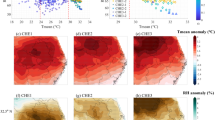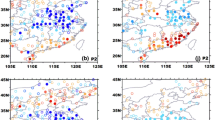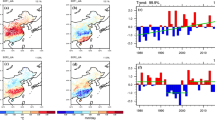Abstract
Hot extremes impose severe effects on human health and the ecosystem, especially when high-temperature extremes sequentially occur in both daytime and nighttime within 1 day, known as Compound Hot Extremes (CHEs). Although a number of studies have focused on independent hot extremes, not enough work is devoted to compound ones, not to mention the coupling strength in covariations between the two variables (daytime and nighttime extreme temperature: Tmax and Tmin) over a given region. The instantaneous coupling strength can be derived by Dynamical System (DS) approach from covariations between Tmax and Tmin over a given region, and used to classify CHEs into coupled and decoupled types. Results show that more frequent coupled CHEs tend to be more intense with prolonged duration and extensive spatial extent compared with decoupled CHEs. Also, the mechanisms behind these two types of CHEs are largely different. Coupled CHEs are accompanied by a significant intensification and westward extension of the western North Pacific subtropical high (WNPSH), and the extremely high-temperature is mainly caused by receiving more solar radiation under the corresponding anticyclone. It is found that barotropic structure, weak jet stream and developing La Niña are conducive to the enhancement and persistence of WNPSH, in favor of the occurrence of long-lasting CHEs. Decoupled CHEs are associated with strong sea-land breeze (SLB), whose diurnal cycle could weaken the persistent large-scale circulation and suppress covariations between Tmax and Tmin. This kind of decoupled hot extremes are attributed to the combined effect of receiving more solar radiation during the day and trapping more long-wave radiation at night, where moisture and cloud cover play an important role.









Similar content being viewed by others
Data availability
All data that support the findings of this study are included within the article (and any supplementary files).
References
Alvarez-Castro C, Faranda D, Yiou P (2018) Atmospheric dynamics leading to west European summer hot temperatures since 1851. Complexity 2018:2494509
Chen R, Wen Z, Lu R (2018) Large-scale circulation anomalies and intraseasonal oscillations associated with long-lived extreme heat events in south China. J Clim 31:213–232
Ding T, Qian W, Yan Z (2010) Changes in hot days and heat waves in China during 1961–2007. Int J Climatol 30:1452–1462
Faranda D, Messori G, Yiou P (2017a) Dynamical proxies of North Atlantic predictability and extremes. Sci Rep 7:278
Faranda D, Messori G, Alvarez-Castro MC, Yiou P (2017b) Dynamical properties and extremes of Northern Hemisphere climate fields over the past 60 years. Nonlinear Process Geophys 24:713–725
Faranda D, Messori G, Yiou P (2020) Diagnosing concurrent drivers of weather extremes: application to warm and cold days in North America. Clim Dyn 54:2187–2201
Fischer EM, Schär CM (2010) Consistent geographical patterns of changes in high-impact European heatwaves. Nat Geosci 3:398–403
Fischer EM, Sippel S, Knutti R (2021) Increasing probability of record-shattering climate extremes. Nat Clim Chang 11:689–695
Gasparrini A, Armstrong BG (2011) The impact of heat waves on mortality. Epidemiology 22:68–73
Guo Y, Huang Y, Fu ZT (2022) Regional compound humidity-heat extremes in the mid-lower reaches of the Yangtze River: a dynamical systems perspective. Environ Res Lett 17:064032
Hersbach H, Bell B, Berrisford P, Hirahara S, Horányi A, Muñoz-Sabater J, Nicolas J, Peubey C, Radu R, Schepers D et al (2020) The ERA5 global reanalysis. Q J R Meteorol Soc 146:1999–2049
Hsu P, Lee J, Ha K, Tsou C (2017) Influences of boreal summer intraseasonal oscillation on heat waves in monsoon Asia. J Clim 30:7191–7211
Hsu P, Qian Y, Liu Y, Murakami H, Gao Y (2020) Role of abnormally enhanced MJO over the western Pacific in the formation and subseasonal predictability of the record-breaking northeast Asian heatwave in the summer of 2018. J Clim 33:3333–3349
Huang Y, Yuan N, Shi M, Lu Z, Fu ZT (2022) On the airsea couplings over tropical Pacific: an instantaneous coupling index using dynamical systems metrics. Geophys Res Lett 49:e2021GL097049
Imada Y, Shiogama H, Takahashi C, Watanabe M, Mori M, Kamae Y, Maeda S (2018) Climate change increased the likelihood of the 2016 heat extremes in Asia. Bull Am Meteor Soc 99:97–101
Jeong DI, Cannon A, Yu B (2022) Influences of atmospheric blocking on North American summer heatwaves in a changing climate: a comparison of two Canadian Earth system model large ensembles. Clim Chang 172:5
Kalnay E, Kanamitsu M, Kistler RE, Collins WD, Deaven DG, Gandin LS, Iredell M, Saha S, White GH, Woollen JS et al (1996) The NCEP/NCAR 40-year reanalysis project. Bull Am Meteor Soc 77:437–471
Kornhuber K, Petoukhov V, Petri S, Rahmstorf S, Coumou D (2016) Evidence for wave resonance as a key mechanism for generating high-amplitude quasi-stationary waves in boreal summer. Clim Dyn 49:1961–1979
Kornhuber K, Coumou D, Vogel E, Lesk C, Donges JF, Lehmann J, Horton RM (2019) Amplified Rossby waves enhance risk of concurrent heatwaves in major breadbasket regions. Nat Clim Chang 10:48–53
Lee HT (2014) Climate Algorithm Theoretical Basis Document (C-ATBD): Outgoing Longwave Radiation (OLR) - Daily. NOAA’s Climate Data Record (CDR) Program, CDRP-ATBD-0526 46
Lee W, Lee M (2016) Interannual variability of heat waves in South Korea and their connection with large-scale atmospheric circulation patterns. Int J Climatol 36:4815–4830
Lee S, Min S (2018) Heat stress changes over East Asia under 1.5° and 2.0 °C global warming targets. J Clim 31:2819–2831
Li X, Ren G, Wang S, You Q, Sun Y, Ma Y, Wang D, Zhang W (2021a) Change in the heatwave statistical characteristics over China during the climate warming slowdown. Atmos Res 247:105152
Li Y, Ding Y, Liu Y (2021b) Mechanisms for regional compound hot extremes in the mid-lower reaches of the Yangtze River. Int J Climatol 41:1292–1304
Lin Q, Yuan J (2022) Linkages between amplified quasi-stationary waves and humid heat extremes in northern hemisphere midlatitudes. J Clim 35(24):4645–4658
Luca PD, Messori G, Faranda D, Ward PJ, Coumou D (2020a) Compound warm-dry and cold-wet events over the Mediterranean. Earth Syst Dyn Discuss 11:793–805
Luca PD, Messori G, Pons FM, Faranda D (2020b) Dynamical systems theory sheds new light on compound climate extremes in Europe and Eastern North America. Q J R Meteorol Soc 146:1636–1650
Lucarini V, Faranda D, Wouters J (2012) Universal behaviour of extreme value statistics for selected observables of dynamical systems. J Stat Phys 147:63–73
Luo M, Lau N (2017) Heat waves in southern China: synoptic behavior, long-term change, and urbanization effects. J Clim 30:703–720
Luo M, Lau N (2020) Summer heat extremes in northern continents linked to developing ENSO events. Environ Res Lett 15:074042
Luo M, Lau N, Zhang W, Zhang Q, Liu Z (2020) Summer high temperature extremes over China linked to the Pacific meridional mode. J Clim 33:5905–5917
Luo M, Lau N, Liu Z (2022) Different mechanisms for daytime, nighttime, and compound heatwaves in southern China. Weather Clim Extrem 36:2212–947
Matthews T, Wilby RL, Murphy C (2017) Communicating the deadly consequences of global warming for human heat stress. Proc Natl Acad Sci 114:3861–3866
Murage P, Hajat S, Kovats RS (2017) Effect of night-time temperatures on cause and age-specific mortality in London. Environ Epidemiol 1(2):e005
Nairn J, Fawcett RJ (2014) The excess heat factor: a metric for heatwave intensity and its use in classifying heatwave severity. Int J Environ Res Public Health 12:227–253
Perkins SE (2015) A review on the scientific understanding of heatwaves: their measurement, driving mechanisms, and changes at the global scale. Atmos Res 164:242–267
Perkins SE, Alexander LV (2013) On the measurement of heat waves. J Clim 26:4500–4517
Perkins SE, Alexander LV, Nairn J (2012) Increasing frequency, intensity and duration of observed global heatwaves and warm spells. Geophys Res Lett 39:L20714
Pfahl S, Wernli H (2012) Quantifying the relevance of atmospheric blocking for co-located temperature extremes in the Northern Hemisphere on (sub-)daily time scales. Geophys Res Lett 39:12807
Qiao S, Chen D, Wang B, Cheung HN, Liu F, Cheng J, Tang S, Zhang Z, Feng G, Dong W (2021) The longest 2020 Meiyu season over the past 60 years: subseasonal perspective and its predictions. Geophys Res Lett 48:e2021CL093596
Qin P (2022) More than six billion people encountering more exposure to extremes with 1.5 °C and 2.0 °C warming. Atmos Res 273:106165
Reynolds RW, Rayner NA, Smith TM, Stokes DC, Wang W (2002) An improved in situ and satellite SST analysis for climate. J Clim 15:1609–1625
Robine J, Cheung SL, Le Roy S, Van Oyen H, Griffiths CE, Michel J, Herrmann FR (2008) Death toll exceeded 70,000 in Europe during the summer of 2003. CR Biol 331(2):171–178
Rousi E, Kornhuber K, Beobide-Arsuaga G, Luo F, Coumou D (2022) Accelerated western European heatwave trends linked to more-persistent double jets over Eurasia. Nat Commun 13:3851
Scherrer SC, Croci-Maspoli M, Schwierz C, Appenzeller C (2006) Two-dimensional indices of atmospheric blocking and their statistical relationship with winter climate patterns in the Euro-Atlantic region. Int J Climatol 26:233–249
Shen L, Zhao C, Ma ZS, Li Z, Li J, Wang K (2019) Observed decrease of summer sea-land breeze in Shanghai from 1994 to 2014 and its association with urbanization. Atmos Res 227:198–209
Stéfanon M, D’Andrea F, Drobinski P (2012) Heatwave classification over Europe and the Mediterranean region. Environ Res Lett 7:014023
Stott PA, Christidis N, Otto FE, Sun Y, Vanderlinden JP, van Oldenborgh GJ, Vautard R, von Storch H, Walton P, Yiou P, Zwiers FW (2016) Attribution of extreme weather and climate-related events. Wiley Interdiscip Rev Clim Chang 7:23–41
Suarez-Gutierrez L, Müller WA, Li C, Marotzke J (2020) Hotspots of extreme heat under global warming. Clim Dyn 55:429–447
Takaya K, Nakamura H (1997) A formulation of a wave-activity flux for stationary Rossby waves on a zonally varying basic flow. Geophys Res Lett 24:2985–2988
Vaidyanathan A, Kegler SR, Saha S, Mulholland JA (2016) A statistical framework to evaluate extreme weather definitions from a health perspective: a demonstration based on extreme heat events. Bull Am Meteor Soc 97(10):1817–1830
Wang Z, Ding Y, Zhang Q, Song Y (2012) Changing trends of daily temperature extremes with different intensities in China. Acta Meteor Sin 26:399–409
Wang B, Xiang B, Lee J (2013) Subtropical High predictability establishes a promising way for monsoon and tropical storm predictions. Proc Natl Acad Sci 110:2718–2722
Wang B, Li J, He Q (2017) Variable and robust East Asian monsoon rainfall response to El Niño over the past 60 years (1957–2016). Adv Atmos Sci 34:1235–1248
Wang J, Chen Y, Tett SF, Yan Z, Zhai P, Feng J, Xia J (2020) Anthropogenically-driven increases in the risks of summertime compound hot extremes. Nat Commun 11:528
Woollings T, Barriopedro D, Methven J, Son S, Martius O, Harvey BJ, Sillmann J, Lupo AR, Seneviratne SI (2018) Blocking and its response to climate change. Curr Clim Chang Rep 4:287–300
Xie S, Du Y, Huang G, Zheng X, Tokinaga H, Hu K, Liu Q (2010) Decadal shift in El Niño influences on Indo-Western Pacific and East Asian climate in the 1970s. J Clim 23:3352–3368
You Q, Jiang Z, Kong L, Wu Z, Bao Y, Kang S, Pepin NC (2016) A comparison of heat wave climatologies and trends in China based on multiple definitions. Clim Dyn 48:3975–3989
Zhang Q, Zheng Y, Singh V, Luo M, Xie Z (2017) Summer extreme precipitation in eastern China: mechanisms and impacts. J Geophys Res: Atmos 122:2766–2778
Zhang T, Tam CF, Lau N, Wang J, Yang S, Chen J, Yu W, Jiang X, Gao P (2022) Influences of the boreal winter Arctic Oscillation on the peak-summer compound heat waves over the Yangtze-Huaihe River basin: the North Atlantic capacitor effect. Clim Dyn 59:2331–2343
Zhu Y, Wang H, Zhou W, Ma J (2011) Recent changes in the summer precipitation pattern in East China and the background circulation. Clim Dyn 36:1463–1473
Zhu J, Wang S, Fischer EM (2021) Increased occurrence of day-night hot extremes in a warming climate. Clim Dyn 59:1297–1307
Acknowledgements
The authors acknowledge the supports from National Natural Science Foundation of China (Nos. 42175065 and 41975059).
Funding
National Natural Science Foundation of China, 42175065 and 41975059.
Author information
Authors and Affiliations
Contributions
YG and ZF conceived the study. YG conducted the analysis. All authors interpreted and discussed the results and wrote the manuscript.
Corresponding author
Ethics declarations
Conflict of interest
The authors declare no competing interests.
Additional information
Publisher's Note
Springer Nature remains neutral with regard to jurisdictional claims in published maps and institutional affiliations.
Supplementary Information
Below is the link to the electronic supplementary material.
Rights and permissions
Springer Nature or its licensor (e.g. a society or other partner) holds exclusive rights to this article under a publishing agreement with the author(s) or other rightsholder(s); author self-archiving of the accepted manuscript version of this article is solely governed by the terms of such publishing agreement and applicable law.
About this article
Cite this article
Guo, Y., Fu, Z. Regional coupled and decoupled day–night compound hot extremes over the mid–lower reaches of the Yangtze River: characteristics and mechanisms. Clim Dyn 61, 2853–2864 (2023). https://doi.org/10.1007/s00382-023-06722-w
Received:
Accepted:
Published:
Issue Date:
DOI: https://doi.org/10.1007/s00382-023-06722-w




